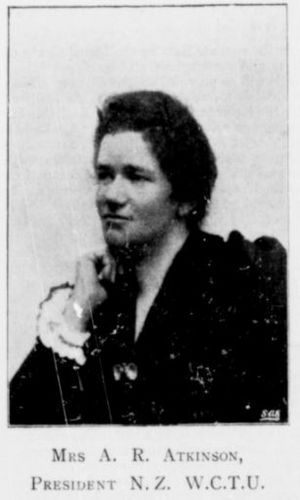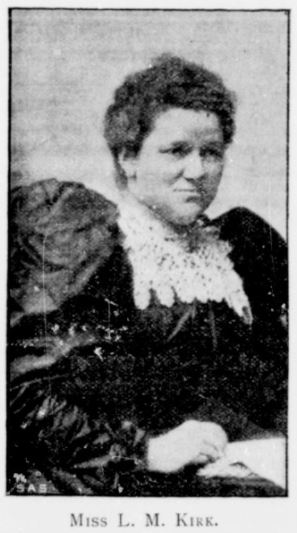Lily Atkinson facts for kids
Quick facts for kids
Lily Atkinson
|
|
|---|---|
 |
|
| Born |
Lily May Kirk
29 March 1866 Auckland, New Zealand
|
| Died | 19 July 1921 (aged 55) Wadestown, New Zealand
|
| Other names | Mrs. A.R. Atkinson |
| Occupation | leader in political and social clubs, including temperance, education reform, advocacy for the rights of women and children |
| Spouse(s) | |
| Children | Tom (1902), Janet Atkinson (1904–1981) |
| Parent(s) | Sarah Jane Mattocks and Thomas Kirk |
| Relatives | brothers: Thomas William Kirk and Harry Borrer Kirk; sisters: Amy Kirk and Cybele Ethel Kirk |
Lily May Atkinson (born Kirk, 29 March 1866 – 19 July 1921) was an important leader in New Zealand. She worked to reduce alcohol use (called temperance). She also fought for women's right to vote (a suffragist) and for equal rights for women (a feminist). Lily held many leadership roles across New Zealand. She was a Vice President of the New Zealand Alliance for stopping alcohol sales. She also led the Women's Christian Temperance Union New Zealand as its president. She was also a Vice President of the National Council of Women of New Zealand.
Contents
Early Life and Education
Lily May Kirk was born in Auckland, New Zealand, on 29 March 1866. Her mother was Sarah Jane Mattocks. Her father was Thomas Kirk, a surveyor and later a professor. He also became the first Chief Conservator of State Forests in New Zealand.
Lily went to Greenwood sisters' Terrace School. She later taught English to Chinese immigrants. She also taught factory workers how to read. Even though she never traveled overseas, she spoke German and French very well. She loved to read books.
Working for Change and Family Life
Lily, her sisters Amy Kirk and Cybele Kirk, and her mother Sarah Jane Kirk were early members of the Women's Christian Temperance Union of New Zealand (WCTU NZ). This group worked to reduce alcohol use. They joined the Wellington branch in 1885. Lily first worked as an Auditor for the Wellington group. Then she became the recording secretary for the national group in 1887. She kept this job for over ten years.
She supported Ellen Hewitt's work with Māori communities. Lily Kirk and Arthur Atkinson spoke about getting information and pledge cards to people in rural areas. They also sent a special letter to Māori women along the Whanganui River.
Writing for The White Ribbon
In 1895, Lily May Kirk joined the team that started The White Ribbon. This was the WCTU NZ's own magazine. It was the first magazine in New Zealand owned, edited, and published by women. Lily wrote the "Wellington Notes" each month. She shared her observations about Parliament, often with a clever sense of humor. For example, she once wrote about how politicians struggled to manage the country's business.
The Forward Movement
Lily and her future husband, Arthur Atkinson, were part of the Forward Movement. This group aimed to apply Christian ideas to modern society. It started in London, England. In New Zealand, it was founded in Wellington in 1893. The Atkinsons joined the management committee at its first meeting.
Fighting Against Alcohol: The New Zealand Alliance
In 1893, the WCTU NZ chose Lily May Kirk to join the Executive Committee of the New Zealand Alliance. This group worked to stop the sale and use of alcohol. In 1898, she became the first woman to be a Vice-President in this group, which was mostly men.
Lily often gave speeches about temperance. People loved her clear, strong voice and charming personality. She was known for her wide and accurate knowledge. In one speech in 1895, she said that the history of alcohol trade came from rich people. She believed they wanted to keep common people under control. People often noted her use of battle words in her fight against alcohol.
As president of the Wellington WCTU, Lily worked with Kate Sheppard. They organized public meetings in Canterbury in 1895. Lily gave talks about temperance in Christchurch, Kaiapoi, and Rangiora. People who heard her talks about the victims of alcohol praised her logical and sympathetic approach.
The Southern Cross Society
Lily and Anna Stout became vice presidents of the Southern Cross Society. This group was founded in Wellington in 1895. Its goal was to educate women of all backgrounds. They wanted to help women who had to earn their own living. The society offered lectures and small meetings about politics and civic topics. This was to help women become better voters. They also wanted women to be ready to serve in Parliament when the law allowed it. Temperance was also part of their lessons.
Lady Stout explained that the society wanted women to have equal rights. She believed homes would be happier when wives could advise their husbands. Lily May Kirk continued to lead this club.
Leading the National WCTU
As "Miss L.M. Kirk," she was the Recording Secretary for the national WCTU convention in 1896. This important role showed her outreach work and her reports on Parliament. It also meant she sent letters on behalf of the national WCTU. She wrote to politicians about issues like women's political rights. This increased her importance at the national level.
In 1897, "Miss L.M. Kirk" was chosen to represent the WCTU NZ at the National Council of Women of New Zealand (NCW NZ). This group was founded in 1896 and worked on many reforms important to women. Kirk gave a speech on "Moral and Scientific Aspect of Temperance" at an NCW NZ meeting in 1897.
She continued her lecture tours in 1897 to help local groups get new members. She visited Brunnerton, Greymouth, Hokitika, and Nelson. The Greymouth WCTU said her voice was "soft and sweet." Her words "sank into the hearts of her hearers and compelled sympathy." She also helped start the Petone branch.
In 1898, the WCTU NZ held a ceremony to honor the American WCTU leader Frances Willard. Kirk gave a speech about the WCTU's work in Japan.
On 11 May 1900, Lily May Kirk married Arthur Atkinson. He was also a temperance activist and a politician. The WCTU NZ gave her a special writing table as a wedding gift. It had a silver plate with an inscription: "Presented to Miss L.M. Kirk, by the New Zealand W.C.T.U., on the occasion of her marriage. May, 1900."
In March 1901, Lily May Kirk Atkinson attended the national WCTU convention. She had been the Recording Secretary for fourteen years. Atkinson was then elected President of the WCTU of New Zealand. Her mother, Sarah Jane Kirk, was president of the Wellington WCTU at that time. Atkinson was president for the next four years. During this time, she had two children: Tom (born 1902, died soon after) and Janet (born 1904).
During her time as president, the WCTU NZ led many social reforms. More areas became "No-License" districts, meaning alcohol sales were banned. This was due to the close work between WCTU NZ and the New Zealand Alliance. In 1906, she stepped down as WCTU NZ president due to poor health. However, she continued her local reform work.
National Council of Women of New Zealand Leadership
Atkinson became Vice President of the National Council of Women of New Zealand (NCW NZ) in May 1901. She served under presidents Margaret Sievwright and Kate Sheppard. By this time, Kirk had changed her mind about women holding political office. In 1903, she joined a group that asked Premier Richard Seddon to remove the ban on women in Parliament. The NCWNZ did not meet again after 1906 until it was restarted in 1918.
Helping Women and Children
Society for the Protection of Women and Children
The New Zealand Society for the Protection of Women and Children started in Auckland in 1893. By 1897, Atkinson and Lady Anna Stout asked for volunteers to start a new branch in Wellington. This branch worked to help women and children. They also supported equal pay for women workers.
Volunteers from the club would go to courts. They watched how judges handled cases of young people or husbands who did not support their families. In 1909, Atkinson led a meeting where they reported finding homes for neglected children. They also found money for poor families.
Training for Women in Home Sciences
Atkinson also worked to improve education for women. She was part of a movement to reform how home economics was taught in colleges. In 1913, Atkinson led two conferences. These conferences discussed creating a new "Domestic Economy" department at Victoria College. The goal was to make this training more professional and modern.
Wellington Pioneer Club
The Pioneer Club was founded in Wellington in 1909. It was based on a similar women's club in London. Lily May Atkinson read the club's rules at the first meeting. The club was for women's education and conversation. It was meant to be non-political, with no alcohol or gambling. Mary Richmond, Atkinson's cousin, became president. Atkinson was elected vice-president. This was the first general women's club in New Zealand.
Liquor Licensing Committee
In 1912, Atkinson was nominated and won a seat on the committee for the Wellington Suburbs and Country Licensing District. This committee made decisions about liquor licenses. She won the seat, showing her continued influence in the temperance movement.
Atkinson was also a leader in the New Zealand Community Welfare Association. She was active in the Plunket Society, which helps mothers and babies. She also supported the Kindergarten Schools Society.
Later Years and Passing
In 1921, Atkinson again served as Recording Secretary at the national WCTU convention. She also agreed to meet with the Minister of Health about a new bill. However, she became too ill to go. She had been campaigning in cold, wet weather. After about a week of feeling sick, she stayed in bed.
She continued her work from bed, correcting Sunday School papers. She tried to write a letter, but could not finish it. Her husband wrote that she passed away peacefully in her sleep on 19 July 1921.
Atkinson died at her home in Wadestown, a suburb of Wellington. Her funeral was held at the Baptist Church. She was buried in an unmarked plot in the Karori Cemetery alongside her parents, her son Tom, and her husband.
Images for kids








